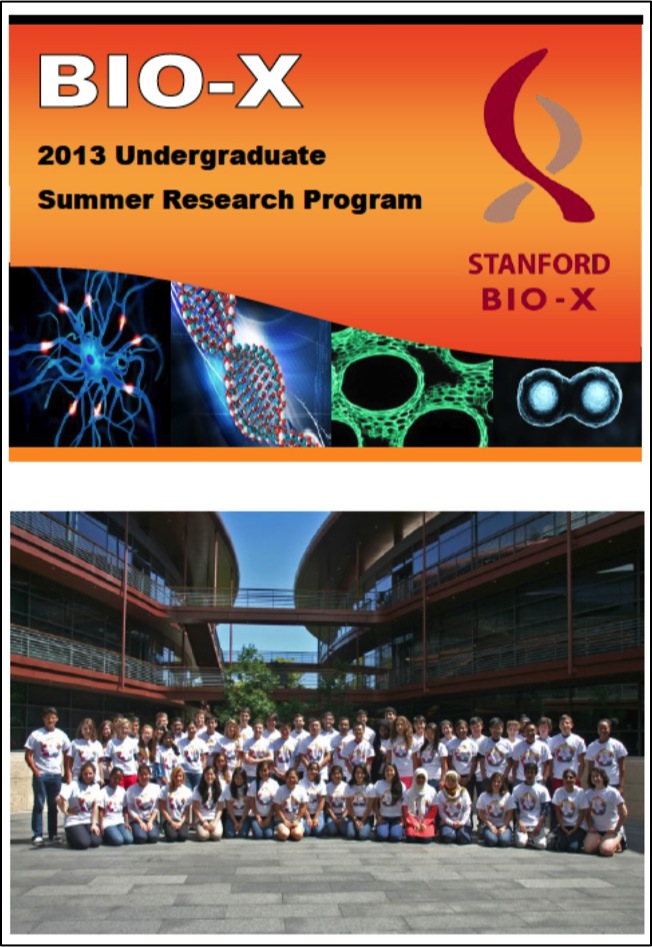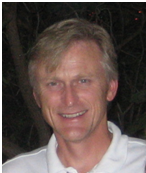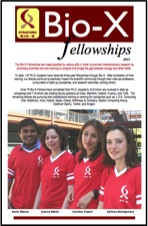
Welcome to the biweekly electronic newsletter from Stanford Bio-X for members of the Bio-X Corporate Forum. Please contact us if you would like to be added or removed from this distribution list, or if you have any questions about Stanford Bio-X or Stanford University.
CHECK OUT STANFORD BIO-X'S NEW SPLASH PAGE!!
Seed Grants
 SEED GRANTS FOR SUCCESS - Stanford Bio-X Interdisciplinary Initiatives Program (IIP)
SEED GRANTS FOR SUCCESS - Stanford Bio-X Interdisciplinary Initiatives Program (IIP)
The Bio-X Interdisciplinary Initiatives Program represents a key Stanford Initiative to address challenges in human health. The IIP awards approximately $3 million every other year in the form of two-year grants averaging about $150,000 each. From its inception in 2000 through the fifth round in 2010, the program has provided critical early-stage funding to 114 different interdisciplinary projects, involving collaborations from over 300 faculty members, and creating over 450 teams from five different Stanford schools. From just the first 5 rounds, the IIP awards have resulted in a 10-fold-plus return on investment, as well as hundreds of publications, dozens of patents filed, and most importantly, the acceleration of scientific discovery and innovation.
In 2012, Stanford Bio-X selected 23 new seed grant projects as the winners of the 6th round. Please go here to view the list of awardees, along with the titles of their projects and the abstracts of the research. Competition was intense as the awardees were chosen from 118 Letters of Intent (LOIs). Selection criteria included innovation, high-reward, and interdisciplinary collaboration. (To view the 114 other IIP projects that have been funded from the first 5 rounds, please click here.) In addition, SANOFI has also funded 4 new Bio-X IIP Seed Grant projects from round 6!
On Monday, August 26, 2013, Bio-X had its second annual IIP Symposium of the year at the Clark Center, which highlights projects that exemplify the Stanford Bio-X mission of crossing boundaries to bring about interdisciplinary research and solutions in the field of life bioscience. The symposium was a huge success with over 300 people attending this event, which included 8 oral presentations and 136 poster presentations. Recorded talks from the symposium will be uploaded soon. If you'd like to view the talks for previous symposia through the years, please click here.
We are cultivating and are highly successful in building meaningful collaborations with numerous corporate colleagues. New collaborations through our seed grant projects are highly encouraged. To learn about how to get involved, please contact Dr. Hanwei Li or Dr. Heideh Fattaey.
Fellowships
Every year, graduate students and postdoctoral scholars of Bio-X affiliated faculty are highly encouraged to apply for the Bio-X Fellowships, which are awarded to research projects that are interdisciplinary and utilize the technologies of different fields to solve different biological questions. Students are encouraged to work collaboratively with professors of different departments, thus creating cross-disciplinary relationships among the different Stanford schools. Our fellows have conducted exciting research, resulting in publications in high-impact journals and have been offered excellent positions in industry and academia. To date, Stanford Bio-X has a total of 152 Fellows.
On June 26th, Bio-X held its annual Bio-X Fellows Symposium, where there were four 15-minute oral presentations followed by one-minute spiels from current fellows. The 25 newest fellows selected this year were also announced, and about 100 attendees came to the symposium. Please click on the "Bio-X Fellows Symposium" link above for the agenda and titles of the talks, and on the icon of the brochure above for the updated and latest Bio-X Fellowships brochure.
To view the numerous projects that have been awarded over the years, please click here.
 BIO-X UNDERGRADUATE SUMMER RESEARCH PROGRAM
BIO-X UNDERGRADUATE SUMMER RESEARCH PROGRAM
The Bio-X Undergraduate Summer Research Program supports undergraduate research training through an award designed to support interdisciplinary undergraduate summer research projects. The program is an invaluable opportunity for students to conduct hands-on research, learn how to carry out experiments in the laboratory, and develop the skills to read and analyze scientific literature.
This program is eligible to Stanford students who want to work in the labs of Bio-X affiliated faculty. To date, 241 students have been awarded the opportunity to participate in the Bio-X Undergraduate Summer Research Program. This summer is Stanford Bio-X's 8th round of USRP.
Participating undergraduates are also required to present poster presentations on the research that they've conducted during the program. Please click here for title lists of past posters that our undergraduates have presented.
Many fruitful collaborations and relationships have been established with industry through fellowships. Please contact Dr. Hanwei Li or Dr. Heideh Fattaey if you'd like to learn more about how to get involved with these fellowship programs.
News
 Scientists reveal how beta-amyloid may cause Alzheimer's
Scientists reveal how beta-amyloid may cause Alzheimer's
Bio-X Director Carla Shatz
Scientists at the Stanford University School of Medicine have shown how a protein fragment known as beta-amyloid, strongly implicated in Alzheimer’s disease, begins destroying synapses before it clumps into plaques that lead to nerve cell death. Key features of Alzheimer’s, which affects about 5 million Americans, are wholesale loss of synapses — contact points via which nerve cells relay signals to one another — and a parallel deterioration in brain function, notably in the ability to remember. “Our discovery suggests that Alzheimer’s disease starts to manifest long before plaque formation becomes evident,” said Carla Shatz, PhD, professor of neurobiology and of biology and senior author of the study, published Sept. 20 in Science. Investigators at Harvard University also contributed to the study. The research, conducted in mice and in human brain tissue, may help to explain the failures in recent years of large-scale clinical trials attempting to slow the progression of Alzheimer’s by pharmacologically ridding the brain of amyloid plaques. It may also point the way to better treatments at earlier stages of the disease. Beta-amyloid begins life as a solitary molecule but tends to bunch up — initially into small clusters that are still soluble and can travel freely in the brain, and finally into the plaques that are hallmarks of Alzheimer’s. The study showed for the first time that in this clustered form, beta-amyloid can bind strongly to a receptor on nerve cells, setting in motion an intercellular process that erodes their synapses with other nerve cells. ... Using an experimental mouse strain that is highly susceptible to the synaptic and cognitive impairments of Alzheimer’s disease, Shatz and her colleagues showed that if these mice lacked a surface protein ordinarily situated very close to synapses, they were resistant to the memory breakdown and synapse loss associated with the disorder. The study demonstrated for the first time that this protein, called PirB, is a high-affinity receptor for beta-amyloid in its “soluble cluster” form, meaning that soluble beta-amyloid clusters stick to PirB quite powerfully. That trips off a cascade of biochemical activities culminating in the destruction of synapses.
To read more about Carla Shatz, Bio-X Director, please click here to the October 2013 article in Discover.
 Stanford scientists build a 'brain stethoscope' to turn seizures into music
Stanford scientists build a 'brain stethoscope' to turn seizures into music
Bio-X Affiliated Faculty Josef Parvizi and Chris Chafe
Bio-X IIP Seed Grant 2012
Josef Parvizi was enjoying a performance by the Kronos Quartet when the idea struck. The musical troupe was midway through a piece in which the melodies were based on radio signals from outer space, and Parvizi, a neurologist at Stanford Medical Center, began wondering what the brain's electrical activity might sound like set to music. He didn't have to look far for help. Chris Chafe, a professor of music research at Stanford, is one of the world's foremost experts in "musification," the process of converting natural signals into music. One of his previous works involved measuring the changing carbon dioxide levels near ripening tomatoes and converting those changing levels into electronic performances. Parvizi, an associate professor, specializes in treating patients suffering from intractable seizures. To locate the source of a seizure, he places electrodes in patients' brains to create electroencephalogram (EEG) recordings of both normal brain activity and a seizure state. He shared a consenting patient's EEG data with Chafe, who began setting the electrical spikes of the rapidly firing neurons to music. Chafe used a tone close to a human's voice, in hopes of giving the listener an empathetic and intuitive understanding of the neural activity. Upon a first listen, the duo realized they had done more than create an interesting piece of music. [Listen to the audio here] "My initial interest was an artistic one at heart, but, surprisingly, we could instantly differentiate seizure activity from non-seizure states with just our ears," Chafe said. "It was like turning a radio dial from a static-filled station to a clear one." If they could achieve the same result with real-time brain activity data, they might be able to develop a tool to allow caregivers for people with epilepsy to quickly listen to the patient's brain waves to hear whether an undetected seizure might be occurring. Parvizi and Chafe dubbed the device a "brain stethoscope."

![]() Stanford scientists working to develop broad-spectrum antiviral drug
Stanford scientists working to develop broad-spectrum antiviral drug
Bio-X Affiliated Faculty Shirit Einav and Steve Quake
Bio-X IIP Seed Grant 2012
When a virus infects a person, it hijacks the body's natural processes in order to fuel its rampage. A pair of Stanford scientists aims to turn this strength into a weakness and develop what could become a broad-spectrum antiviral drug. Most antiviral drugs are concocted to act against a specific viral protein. As such, they usually provide a "one drug/one bug" approach. "Penicillin can kill many types of bacteria, but most antiviral drugs work only against one virus, and sometimes a single subtype of a virus," said Shirit Einav, an assistant professor of medicine and of microbiology and immunology at Stanford School of Medicine. Additionally, targeting viral proteins is problematic; viruses can mutate quickly, and a single change in the viral sequence can render it fully resistant to the drug. "With the exception of HIV, we still have very few antiviral drugs to offer patients with viral infections, and even those are often quite limited," Einav said. "No approved antiviral drugs or vaccines are available for emerging viruses, such as dengue, which pose major challenges to global health." Viruses live within our cells and rely upon host cell machineries in order to replicate. Instead of targeting the virus directly, the solution, Einav said, may be to instead interfere with host cell proteins that are utilized by multiple viruses. "We treat diabetes and hypertension by targeting host proteins, so why not viral infections?" Einav said. With support from Stanford's Bio-X Interdisciplinary Initiatives Program (Bio-X IIP), Einav and Stephen Quake, a professor of bioengineering, have developed a process of identifying human proteins that wide families of viruses depend on for their success.
![]()

Stanford scientists build a microscope to spot the seeds of cancer
Bio-X Affiliated Faculty Chris Contag, Michael Clarke, Olav Solgaard, and Geoffrey Gurtner
Bio-X IIP Seed Grant 2012
One of the cruelest truths about cancer is that even after you beat the disease, it can still come back to kill you. A tumor growing in the prostate gland, breast, or any other organ can shed cancerous cells into the blood. These cancerous seeds travel the body and can take root nearly anywhere, growing into a new cancer threat even after the initial cancer is treated. The rule of thumb with cancer is that the earlier you can detect the disease, the more effective the treatment, and hence better potential outcomes. Currently, doctors draw a patient's blood and analyze it using special antibodies to detect the presence of the seeds, called circulating tumor cells (CTCs). This works well if CTCs are present in large numbers, but may fail to detect smaller numbers released by earlier tumors. Now, a team of engineers, scientists and doctors from Stanford is developing a mini-microscope that might be able to noninvasively detect the CTCs earlier than ever, allowing for earlier interventions. "There has been a huge push to increase sensitivity," said Bonnie King, an instructor at Stanford School of Medicine. "We suspect that CTCs often circulate in numbers below our current threshold of detectability." A major advantage with the microscopic technique, King said, is the ability to screen much larger volumes of blood, rather than just a small vial collected from a patient. This will be done using a method called in vivo flow cytometry – a laser-based technology for counting cells in a live subject.

 FDA-approved antidepressant may combat deadly form of lung cancer, study finds
FDA-approved antidepressant may combat deadly form of lung cancer, study finds
Bio-X Affiliated Faculty Atul Butte and Julien Sage
A little-used class of antidepressants appears potentially effective in combating a particularly deadly form of lung cancer, according to a new study from researchers at the Stanford University School of Medicine. And because the drugs have already been approved by the U.S. Food and Drug Administration for use in humans, the researchers have been able to quickly launch a clinical trial to test their theory in patients. The phase-2 trial is now recruiting participants with small-cell lung cancer and other, similar conditions like aggressive gastrointestinal neuroendocrine cancers. The “repositioning” of an existing drug to treat a disorder other than the one for which it was originally approved is an example of how extremely large genetic and biological databases are changing the face of medicine. “We are cutting down the decade or more and the $1 billion it can typically take to translate a laboratory finding into a successful drug treatment to about one to two years and spending about $100,000,” said Atul Butte, MD, PhD, associate professor of pediatrics. Butte is the division chief of systems medicine and director of the Center for Pediatric Bioinformatics at Lucile Packard Children’s Hospital at Stanford. He is a co-senior author of the study, published online Sept. 27 in Cancer Discovery. Julien Sage, PhD, associate professor of pediatrics, is the other senior author. The study’s lead author is postdoctoral scholar Nadine Jahchan, PhD. Joel Neal, MD, PhD, an assistant professor of medicine, is the principal investigator for the clinical trial.
Events
| Genetics October 2, 2013, 4 pm - 5 pm Alway M-106, Stanford, CA FRONTIERS IN BIOLOGY: "RNA-guided genome defense and genetic re-programming by a CRISPR endonuclease" Speaker: Jennifer Doudna, PhD, Univ. of California Berkely |
Neurosciences Institute October 3, 2013, 12 pm - 1 pm Clark Room S360, Stanford, CA "Itching for answers: the molecules and mechanisms of itch, touch and pain transduction" Speaker: Diana Bautista, PhD, UC Berkeley |
| Developmental Biology October 9, 2013, 4 pm - 5 pm Munzer Auditorium, Stanford, CA FRONTIERS IN BIOLOGY - "Reprogramming Cell Fates" Speaker: Marius Wernig, MD, PhD, Stanford University |
Bio-X October 10, 2013, 3:15 pm - 4:15 pm Clark Center Auditorium, Stanford, CA Bio-X Seminar - "From ideation to implementation: The journey of creating solutions that work in global health" Speaker: Shirley Villadiego, MD, MPH, Ortho Clinical Diagnostics, Part of the Johnson & Johnson Family of Companies |
Resources
| Stanford University |
| Stanford Bio-X |
| Bio-X Seed Grants The Stanford Bio-X Interdisciplinary Initiatives Program (IIP) provides seed funding for high-risk, high-reward, collaborative projects across the university, and have been highly successful in fostering transformative research. |
| Office of Technology and Licensing "Techfinder" Search the OTL Technology Portal to find technologies available for licensing from Stanford. |
| Stanford Center for Professional Development - Take advantage of your FREE membership! - Take online graduate courses in engineering, leadership and management, bioscience, and more. - Register for free webinars and seminars, and gets discounts on courses. |
| Stanford Biodesign Video Tutorials on how FDA approves medical devices A series of video briefs recently produced by the Stanford Biodesign Program teaches innovators how to get a medical device approved for use in the United States. This free, online library of 60 videos provides detailed information on the Food and Drug Administration regulatory process, short case studies and advice on interacting with the FDA. |
To learn more about Stanford Bio-X or Stanford University, please contact Dr. Hanwei Li, the Bio-X Corporate Forum Liaison, at 650-725-1523 or lhanwei1@stanford.edu, or Dr. Heideh Fattaey, the Executive Director of Bio-X Operations and Programs, at 650-799-1608 or hfattaey@stanford.edu.


